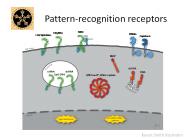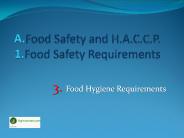Pathogen Killer PowerPoint PPT Presentations
All Time
Recommended
Infectious diseases are responsible for a quarter to a third of all ... Responsible for: Athlete's foot, ringworm. www.BioEdOnline.org. BioEd Online. Animals ...
| PowerPoint PPT presentation | free to view
Acute infantile gastroenteritis 40, 41 10. Intussusception 1, 2, ... Live attenuated vaccines now available for use in children Noroviruses (Norwalk-like) ...
| PowerPoint PPT presentation | free to download
Title: Immune system of mammals Author: DE&T User Last modified by: Sally Gerring Created Date: 5/17/2006 8:12:12 AM Document presentation format
| PowerPoint PPT presentation | free to view
FL beach water naturally contains viruses and bacteria ... Vibrio vulnificus is common in the Gulf in ... http://www.virology.net/Big_Virology/BVRNAcalici.html ...
| PowerPoint PPT presentation | free to view
This week: Protection from Pathogens * esophagus stomach Taking in food and oxygen exposes us to pathogens Pathogen: a disease causing agent Ebola E. coli Fungus from ...
| PowerPoint PPT presentation | free to download
"Insect Killer Services Pvt. Ltd offers complete pest control services (cockroach control, termite control, flies control, bedbugs control, mosquito control, bird control, rodent control, residential and commercial pest control). !!HIRE US TODAY!! CALL: 98280-81758 OR VISIT: http://pestcontroljaipur.com/
| PowerPoint PPT presentation | free to download
Natural killer (NK) cells are large, granular, bone marrow-derived ... protein of plasma membrane or endosome allowing granzymes to enter target cell cytoplasm ...
| PowerPoint PPT presentation | free to view
1930s: Pasteurization of milk ... Improved milk handling and processing technology ... The Epidemiology of Raw Milk - Associated Foodborne Disease Reported in the ...
| PowerPoint PPT presentation | free to view
Insect Killer Services Pvt. Ltd offers complete pest control services (cockroach control, termite control, flies control, bedbugs control, mosquito control, bird control, rodent control, residential and commercial pest control). !!HIRE US TODAY!! CALL: 98280-81758 OR VISIT: http://pestcontroljaipur.com/
| PowerPoint PPT presentation | free to download
Immune System Important system that helps fight off pathogens What is a Pathogen? Microorganism that causes infection or a disease: Bacteria Viruses Fungi ...
| PowerPoint PPT presentation | free to download
... large WBC that attacks infected cells causing the cell to swell and burst. ... Histamine causes redness, swelling, runny nose, itchy eyes and congestion. ...
| PowerPoint PPT presentation | free to view
First Aid Tips. Stay Calm ... First Aid Tips (cont'd) Check for a medical ... Treat all first aid situations where blood or other body fluids are present as ...
| PowerPoint PPT presentation | free to view
Title: Medical Arachnoenthomology. Phylum Arthropoda. Class Crustacea. Class Arachnida. Class Insecta. Author: 1 Last modified by: Admin Created Date
| PowerPoint PPT presentation | free to view
Basophil. Eosinophil. Neutrophil. Monocyte. Dendritic cell. Macrophage. Natural. killer cell ... Pathogens cultivated under laboratory conditions, dissected ...
| PowerPoint PPT presentation | free to view
Discoveries in the last 15 years enable faster discovery and ... Pathogenomics and EDVs are opening up the haustorial interface to molecular analysis ' ...
| PowerPoint PPT presentation | free to view
The macrophage then exhibits the antigens from the destroyed bacterium ... Macrophages engulf the agglutinate. SUMMARY. PATHOGEN. T KILLER CELLS. T MEMORY CELLS ...
| PowerPoint PPT presentation | free to view
Phagocytes-White blood cells that destroy pathogens by surrounding and engulfing ... Killer T can bind to the pathogen or phagocyte and destroy directly ...
| PowerPoint PPT presentation | free to view
Immune System Flow Chart Pathogen Disease causing agent Macrophage Move to site of infection and ingests bacteria and debris T-Cell The killer T cells serve to then ...
| PowerPoint PPT presentation | free to view
Macrophage Mannie's mug shot. Mannie's message to 'snake eyes' (the pathogen) ... King Kong the Killer T-cell Mug shot. King Kong's message to Snake Eyes (the ...
| PowerPoint PPT presentation | free to view
Immune System Immune System Body s defense against disease-causing organisms (pathogens) Immune System First line of defense: Barriers that keep pathogens from ...
| PowerPoint PPT presentation | free to view
It is a drug delivery robot and used to kill pathogens in human body
| PowerPoint PPT presentation | free to download
The Immune System Pathogens include certain bacteria, protists, fungi, and worms, and viruses. Diseases that are caused by pathogens are known as infectious diseases ...
| PowerPoint PPT presentation | free to view
Everything You Wanted to Know About the Immune System And More!!! Keeping Pathogens OUT!!! Always exposed to pathogens! Body destroys most all of them Remember ...
| PowerPoint PPT presentation | free to download
Type III Secretion System Complex protein secretion system employed by many Gram-negative pathogenic bacteria Transport bacterial effector proteins across three ...
| PowerPoint PPT presentation | free to download
Phagocytes Killer T-cells Immunology Macrophages Natural Killer Cells Immune System Group of cells in the body that recognize foreign substances F(x) = to neutralize ...
| PowerPoint PPT presentation | free to download
... (PAMPs, pathogen-associated molecular patterns) or cell ... TIR-domain-containing adaptor protein inducing IFN PRR ligands ATP, adenosine triphosphate ...
| PowerPoint PPT presentation | free to download
Immune System Important system that helps fight off pathogens What is a Pathogen? Microorganism that causes infection or a disease: Bacteria Viruses Fungi ...
| PowerPoint PPT presentation | free to download
Preventing Communicable Diseases How might behaviors such as wearing appropriate safety equipment help protect you from pathogens?
| PowerPoint PPT presentation | free to download
Defense Against Infectious Disease Review Disease- a disruption of homeostasis Infectious disease- caused by a pathogen Pathogen- disease producing organism such as ...
| PowerPoint PPT presentation | free to view
CHAPTER 43 THE BODY S DEFENSES The Nature of Disease Types of Pathogenic Organisms Mechanisms of Disease by Pathogens Viruses Bacteria Body Coverings: The Skin Body ...
| PowerPoint PPT presentation | free to view
... natural killer cells ... Less support fewer natural killer (NK) cells, but that did not ... Natural killer cells: can kill a variety of invaders (w/o MHC I) ...
| PowerPoint PPT presentation | free to view
... (ITAM), activating receptor -KLR(killer lectin-like receptor): Heterodimer of CD94 & NKG2 (C type lectin) CD94: short cytoplastic region, no signal ...
| PowerPoint PPT presentation | free to view
... PAMP Pathogen recognition receptors (PRR) ex: CD14, TLRs, Nods, PRR: r cepteurs de l h te qui reconnaissent les PAMPs Par : ...
| PowerPoint PPT presentation | free to view
BODY DEFENSES NON-SPECIFIC DEFENSES CELLS AND CHEMICALS a. Interferon- b. Complement- c. Phagocytes- d. Natural Killer (NK) Cells- THE LYMPHATIC SYSTEM Consists of ...
| PowerPoint PPT presentation | free to view
Risk and Toxicology Chapter 18 Smoking in the US Smoking is the number one killer in the US Worldwide, infectious disease is the number one killer.
| PowerPoint PPT presentation | free to download
Leukocytes (white blood cells) Lymphocytes Phagocytes T Cells B Cells Helper T Cells Killer T Cells Supressor T Cells Natural Killer T Cells Memory T Cells Plasma B ...
| PowerPoint PPT presentation | free to view
FIGHTING DISEASE Pathogen-a disease-causing microorganism The Immune System: Layers of Defense 1. Innate immunity - immediate but non-specific - includes: External ...
| PowerPoint PPT presentation | free to view
CHAPTER 43 THE BODY S DEFENSES The Nature of Disease Types of Pathogenic Organisms Mechanisms of Disease by Pathogens Viruses Bacteria Body Coverings: The Skin Body ...
| PowerPoint PPT presentation | free to view
Human Disease Caused by the Inhalation of 'Killer Mold' ... 'Killer Mold' is only rarely found in the air and its mycotoxins are not breathable. ...
| PowerPoint PPT presentation | free to view
Chapter 43 The Immune System Overview: Reconnaissance, Recognition, and Response An animal must defend itself from the many dangerous pathogens it may encounter ...
| PowerPoint PPT presentation | free to download
The Immune System Biology Chapter 41 Pathogen-disease causing agent (various types of bacteria, viruses, fungi, protists) Body uses both specific and nonspecific ...
| PowerPoint PPT presentation | free to download
This lesson put emphasis on food safety requirements, pathogenic microorganisms and foods, basic rules for food preparation, staff obligations, food contamination and staff, food safety hazards, advantages of H.C.C.C.P.
| PowerPoint PPT presentation | free to view
The Immune System Disease Transmission Robert Koch father of disease, came up with first procedure for identifying the pathogens responsible for a disease.
| PowerPoint PPT presentation | free to view
LOWER RESPIRATORY TRACT INFECTIONS Prof T Rogers PNEUMONIA THE IMPORTANCE OF PNEUMONIA A major killer in both developed and developing countries Accounts for more ...
| PowerPoint PPT presentation | free to view
Lacking adaptive immunity results in a slight increase in pathogen load and a ... Genes are very ancient (found in Xenopus & Fugu) ...
| PowerPoint PPT presentation | free to download
The Immune System Basics Pathogens of Disease Bacteria Bacteria are cellular (prokaryotic) and are Living organisms - 3 common shapes Bacilli (rod), cocci (circular ...
| PowerPoint PPT presentation | free to view
Tropical Protozoa Introduction to Protozoa Kingdom DNA data suggests actually several kingdoms. ... Malaria - Epidemiology #5 Killer, 1-3 million die annually, ...
| PowerPoint PPT presentation | free to download
Shnayerson and Plotkin, The Killers Within. The Deadly Rise of Drug-Resistant Bacteria. ... agent: Chemical that kills or inhibits the growth of microorganisms ...
| PowerPoint PPT presentation | free to view
The Immune System: The Mind Body ... for air borne pathogens First line Immune defense: The non-specific Macrophage ... NE Conditioning the Immune response ...
| PowerPoint PPT presentation | free to view
PP. 957-960 Fights pathogens to prevent infections and disease Works with the lymphatic system (collects fluid and returns it to the blood) Lymphocytes: white blood ...
| PowerPoint PPT presentation | free to download
Fighting Diseases Causes of Disease many diseases are caused by microorganisms, called pathogens they enter the body (called an antigen) and either damage tissues or ...
| PowerPoint PPT presentation | free to download
Immune System The Body s Defense System Types of Pathogens: Agents that can cause disease Viruses Bacteria Protists Worms Fungi Nonspecific Defenses First Line ...
| PowerPoint PPT presentation | free to view
Immune System * Immune System System of chemicals, white blood cells, and tissues that protect the body against pathogens (disease causing microorganisms) Immune ...
| PowerPoint PPT presentation | free to download
... or non-specific. Response is the same for ... Pathogens are germs or disease-causing invaders that enter the body. The immune system attacks and destroys ...
| PowerPoint PPT presentation | free to view
3 General Symptoms of the Body Fever Shock Pain Fever An increased temperature by the body to destroy invading pathogens. Life is protein-dependent, soooo .
| PowerPoint PPT presentation | free to view
The Differentiation of Vertebrate Immune Cells In the immune system, two types of cells participate directly in defense against pathogens. Plasma B cells produce and ...
| PowerPoint PPT presentation | free to download
























































